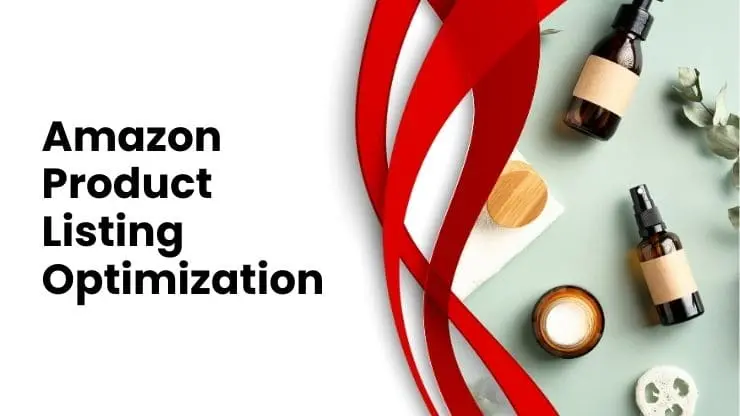In the expansive digital marketplace that Amazon Product listing Optimization, standing out is not merely a choice; it’s a fundamental necessity. The labyrinth of Amazon’s product catalog demands a profound understanding of product listing optimization, ensuring that your offerings not only find a place but effortlessly captivate potential buyers. Let’s delve into the intricacies of this optimization process, unraveling the complexity, and explore how sellers can elevate their game on this e-commerce giant.
The Role of Amazon Product Listing Optimization
Streamlining item postings on Amazon assumes an essential part in expanding perceivability, expanding deals, and guaranteeing the progress of merchants and brands on the stage. With a large number of items accessible, standing apart from the opposition is fundamental, and compelling streamlining strategies can have a huge effect.
The following are important aspects of optimizing Amazon product listings:
Watchwords: Involving applicable catchphrases in item titles, list items, and depictions further develops search perceivability and assists likely clients with finding items without any problem. Leading catchphrase examination to recognize high-traffic and important terms is fundamental.
Convincing Copywriting: Creating influential and educational item depictions that feature key elements, advantages, and special offering focuses can convince clients to make a buy. Clearness, compactness, and connecting with duplicates can altogether affect transformation rates.
High-Quality Images: Including images of high resolution that show products from a variety of perspectives and in a variety of settings improves the shopping experience and builds customer trust. Pictures ought to precisely address the item and its elements.
Cutthroat Estimating: Setting serious costs in view of statistical surveying and contender examination can draw in cost-conscious customers and work on the probability of deals. Amazon’s calculation likewise thinks about valuing while positioning items in query items.
Upgraded Content: Using Amazon’s Improved Image Content (EBC) or A+ Content (for enlisted brands) permits merchants to make outwardly engaging and instructive item pages with extra pictures, recordings, and rich media. Upgraded content can further develop commitment and transformation rates.
Item Audits and Evaluations: Empowering positive surveys and overseeing client criticism can support believability and dependability, eventually affecting buy choices. Giving fantastic client support and resolving any issues quickly can prompt higher appraisals and surveys.
Understanding Amazon’s Algorithm
Understanding Amazon’s A9 Algorithm is vital for venders hoping to amplify their perceivability and deals on the stage. Although the algorithm’s inner workings are secret and constantly changing, the following factors have been identified as influencing product ranking:
Importance: The calculation thinks about how intently an item matches the pursuit inquiry entered by a client. Advancing item postings with pertinent watchwords, titles, and depictions improves the probability of showing up in applicable indexed lists.
Performance Metrics: Products with high levels of engagement and conversion are given preference by Amazon. Factors like active clicking factor (CTR), transformation rate, and deal speed assume a critical part in deciding positioning. Items with better execution measurements are probably going to rank higher in indexed lists.
Consumer loyalty: Positive client input, including evaluations and surveys, is fundamental for keeping a decent standing on Amazon. Items with higher appraisals and more sure surveys are inclined toward the calculation and will generally rank higher.
Item Posting Fulfillment: Complete and exact item postings are bound to rank well on Amazon. This incorporates giving nitty-gritty item portrayals, top-notch pictures, and pertinent traits. Fragmented or ineffectively streamlined postings might be punished in search rankings.
Stock Accessibility: Items that are available and accessible for purchase are bound to rank higher in the list of items. Amazon focuses on items that can be satisfied rapidly and dependably, as this further develops the general client experience.
Pricing: Product rankings on Amazon can be affected by competitive pricing. While not the sole determinant, valuing comparative with contenders and market patterns can influence an item’s perceivability and deal execution.
Keyword Research and Analysis
The fundamental components of optimizing Amazon product listings are keyword research and analysis. You can increase your product’s visibility and discoverability by locating relevant keywords, resulting in increased sales.
Effective keyword research requires the use of the following tools and methods:
Autocomplete and Related Searches From Amazon: To begin, use the Amazon search bar to type relevant search terms related to your product. Observe the autocomplete ideas and related look through that show up, as these can give bits of knowledge into famous pursuit questions.
Amazon’s Pursuit Expressions Report: Examine the hunt terms report accessible in your Amazon Dealer Focal record to see which catchphrases are directing people to your postings. This report can assist you with recognizing high-performing watchwords to focus on in your advancement endeavors.
Watchword Exploration Apparatuses: Use outsider catchphrase research devices, for example, Helium 10, Wilderness Scout, or MerchantWords, to distinguish significant catchphrases and survey their hunt volume, rivalry, and pertinence to your item. These apparatuses frequently give important experiences into moving watchwords and search patterns.
Contender Examination: Break down the watchwords utilized in your rivals’ item postings to recognize holes and open doors. Search for normal catchphrases and expressions utilized by top-performing contenders and consider integrating them into your own postings.
Long-Tail Catchphrases: Don’t disregard long-tail watchwords, which are longer and more unambiguous inquiry questions. While they might have lower search volume, they frequently have higher transformation rates as they target more unambiguous client aims. Long-tail watchwords can assist you with contacting a more designated crowd and stand apart from contenders.
Client Surveys and Criticism: Focus on the language and phrasing involved in clients’ audits and criticism. This can give significant experiences into how clients depict and look for your item, assisting you with distinguishing extra pertinent catchphrases to remember for your postings.
Occasional Patterns and Occasions: Think about occasional patterns and occasions that might influence search conduct and buying designs. Change your catchphrase technique likewise to profit by these potential open doors and augment your item’s perceivability during busy times.
Crafting Compelling Product Titles
Creating convincing item titles is fundamental for drawing in the consideration of likely clients and augmenting perceivability on Amazon.
Here are a few procedures for making eye-catching titles and best practices for watchword situation:
Keep It Clear and Brief: Item titles ought to be clear, compact, and simple to peruse. The title should not contain any information or words that aren’t needed and run the risk of confusing readers. Go for the gold that precisely portrays the item in a couple of words.
Feature Key Elements: Remember significant highlights or advantages of the item for the title to get the attention of clients perusing indexed lists. Center around one-of-a-kind selling focuses that separate your item from rivals.
Utilize Pertinent Catchphrases: Integrate significant watchwords into the title to further develop search perceivability and assist clients with tracking down your item. Place essential catchphrases around the start of the title for greatest effect; however, guarantee the title stays normal and clear.
Take Branding into Account: If it’s possible, include your brand name in the title to increase customer trust and brand recognition. Nonetheless, focus on including applicable item data and catchphrases over brand makes reference to assuming space is restricted.
Optimize for Mobile: Consider that many customers browse Amazon on mobile devices, which have limited screen space. Make titles that are versatile and show well on more modest screens without shorting significant data.
Follow Amazon’s Guidelines: Be sure to follow Amazon’s guidelines for product titles, which include content that is not allowed and character limits. Titles that abuse Amazon’s rules might be stifled or taken out of indexed lists.
Test and Emphasize: Examination with various title organizations and varieties to see which ones perform best as far as navigate rates and change rates. Screen execution measurements and change titles appropriately to streamline the progress.
Incorporate Item Particulars: If pertinent and space licenses exist, incorporate significant item details like size, variety, amount, or material in the title. Without having to click on the listing, this can help customers quickly determine whether the product meets their requirements.
Writing Persuasive Product Descriptions
Composing convincing item portrayals is fundamental for changing over likely clients into purchasers on Amazon.
Here is a life structure for a compelling item depiction and how to normally consolidate catchphrases:
Presentation: Begin with a convincing presentation that catches the peruser’s eye and features the vital advantages or elements of the item. Utilize connecting with language to arouse interest and empower further perusing.
Elements and Advantages: Give a definite portrayal of the item’s highlights and advantages, focusing on how it takes care of the client’s concern or satisfies their necessities. Featured special selling focuses and makes sense of why the item merits buying.
Determinations: Incorporate significant item particulars like aspects, materials, variety choices, and whatever other significant subtleties that clients might need to be aware of prior to making a buy. Put this information together in a way that is easy to understand.
Use Descriptive Language: To vividly convey the benefits of the product, use descriptive language. Appeal to the client’s faculties and feelings by depicting how the item looks, feels, and performs.
Address Client Concerns: Expect and address normal client concerns or complaints in the item depiction. Give consolation and conquer protests by featuring guarantees, certifications, or merchandise exchanges.
Social Verification: Consolidate social confirmation components, for example, client surveys, tributes, or evaluations, to fabricate trust and validity with expected purchasers. Feature positive input and encounters from fulfilled clients.
Source of inspiration: Toward the finish of the item portrayal, incorporate areas of strength for a to activity that captivates the peruser to make the following stride, for example, buying the item, reaching client care, or investigating items that are like it.
Follow these guidelines to naturally incorporate keywords into the product description:
Focus on Comprehensibility: Spotlight on composing top-caliber content and connecting with content that streams normally and is not difficult to peruse. Abstain from stuffing watchwords unnaturally or forfeiting comprehensibility for streamlining.
Vital Arrangement: Consolidate catchphrases decisively all through the item depiction, remembering for the title, presentation, list items, and body message. Use varieties of the catchphrase to stay away from reiteration and keep up with clarity.
Context-oriented pertinence: Guarantee that catchphrases are applicable to the item and relevantly proper inside the depiction. Use equivalent words and related terms to normally coordinate catchphrases without sounding constrained.
Compose for People, Not Simply Web crawlers: Recall that at last, the item portrayal is expected to convince and illuminate human perusers. Center around composing convincing, influential duplicate that reverberates with your interest group while as yet consolidating important catchphrases for website streamlining.
Optimizing Bullet Points and Product Features
It is essential to optimize product features and bullet points in order to attract potential customers and convince them to buy from Amazon.
This is the way to augment the effect of list items and feature interesting selling focuses:
Succinct and Enlightening: Keep list items brief and zero in on the main elements and advantages of the item. Every list item ought to pass important data in an unmistakable and simple-to-understand design.
Feature Key Elements: Use list items to feature the critical highlights and particulars of the item that put it aside from contenders. Concentrate on unique, innovative, or particularly customer-friendly features. Identify and address common problems or pain points that your target audience may be experiencing and emphasize how the product addresses these issues. Featuring the advantages of the item can assist clients with understanding why they need it.
Utilize Powerful Language: Utilize enticing language in list items to catch the peruser’s eye and urge them to peruse. Center around benefits as opposed to simply posting highlights, and use activity arranged language to rouse activity.
Focus on Significant Data: Organize lists arranged by significance, with the most convincing and important data at the top. This guarantees that clients see the main offering first and helps to keep their consideration centered.
Consolidate Watchwords Normally: Remember applicable catchphrases for list items to further develop search perceivability and assist clients with tracking down your item. Notwithstanding, keep away from watchword stuffing and guarantee that catchphrases are incorporated normally into the list items.
Feature Interesting Selling Focuses: Use list items to feature the novel selling points of the item, like its predominant quality, inventive plan, or select highlights. Make it clear to clients why they ought to pick your item and what separates it from contenders.
Use Slugs Sparingly: While list items are a successful method for conveying key data, try not to overpower clients with an excessive number of shots. Adhere to the main selling focuses and keep the general length of the list items reasonable.
Pricing Strategies: The Dynamic Rhythm of Profitability
Price is the crucial rhythm in Amazon’s algorithmic symphony. Striking the right balance between competitiveness and profitability, sellers must implement dynamic pricing strategies – discounts, bundling, or limited-time offers – contributing to a crescendo of increased visibility and conversion rates.
Reviews and Ratings: The Harmonious Chorus of Trust
Positive customer reviews and high ratings build a harmonious chorus of trust that resonates through the digital halls of Amazon. Encouraging satisfied customers to contribute to this chorus and promptly addressing concerns creates a positive feedback loop, enhancing the overall symphony of your product listing optimization.
Enhanced Brand Content: Crafting an Epic Tale
Leveraging Enhanced Brand Content allows sellers to narrate their brand’s epic tale through engaging multimedia content. This feature enhances the overall shopping experience, differentiating your brand and products from competitors, creating a symphony that echoes in the minds of potential buyers.
Monitoring and Adjustment: The Ongoing Symphony of Optimization
Optimization is not a singular melody but an ongoing symphony. Regularly monitoring the performance of your product listings and analyzing data allows for data-driven adjustments. This may involve tweaking keywords, updating images, or refining pricing strategies in response to the ever-changing rhythm of customer behavior.
Competitor Analysis: A Sonata of Strategy
Understanding the strategies of competitors is a pivotal movement in the symphony of effective optimization. Utilizing tools and methods for competitor analysis provides valuable insights that harmonize with your own optimization strategies, keeping you in tune with the marketplace’s ever-evolving melody.
Mobile Optimization: The Crescendo of Mobile Users
As mobile shopping takes center stage, optimizing product listings for mobile users becomes imperative. Ensuring that your listings are not just mobile-friendly but orchestrate a seamless performance on various devices contributes to the crescendo of a harmonious shopping experience.
Amazon Ads: The Strategic Crescendo
Amazon offers various advertising options that contribute to the strategic crescendo of product visibility. Sponsored Products, Sponsored Brands, and Display Ads allow sellers to compose their products’ symphony strategically, targeting specific audiences with a harmonious resonance.
Staying in Tune with Policies: The Compliance Minuet
The e-commerce landscape dances to the tune of dynamic policies, and Amazon frequently changes the rhythm. Staying informed about these changes ensures that your listings remain in compliance, avoiding potential penalties that could disrupt the harmonious flow of visibility.
Conclusion: The Harmonic Echo of Success
In the ever-evolving world of e-commerce, Amazon product listing optimization is not a solo performance but a continuous symphony. Success on the platform demands a holistic symphony that integrates keywords, engaging content, multimedia, and strategic adjustments based on real-time data. By mastering the art of optimization, sellers can compose a symphony that resonates, propelling their products to the forefront of Amazon’s vast marketplace.
FAQs: Unveiling the Enigmatic
- How frequently should I fine-tune my product listings for optimization?
- The rhythm of regular updates is recommended, especially when there are shifts in customer behavior, market trends, or Amazon’s algorithms.
- Can the dissonance of negative reviews impact my products’ visibility?
- Yes, negative reviews carry a dissonant note that can influence the perception of your products and disrupt their visibility. Promptly addressing issues and orchestrating improvements is crucial for maintaining a harmonious tune.
- Are there symphonic tools for effective keyword research on Amazon?
- Indeed, several tools, such as Jungle Scout and Helium 10, play a symphony of assistance in conducting comprehensive keyword research.
- Is the crescendo of mobile optimization truly necessary for Amazon listings?
- Absolutely. With an increasing number of users composing their shopping melodies on mobile devices, ensuring mobile optimization orchestrates a seamless and harmonious shopping experience.
- How can I compose a strategic crescendo with Amazon advertising for my products?
- Experiment with different ad formats, harmonize with relevant keywords, and regularly monitor the symphony’s performance to fine-tune your advertising strategy.



